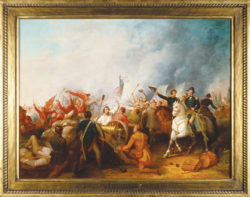Fall 2014
Remembering Andrew Jackson
An exhibition at HNOC coincides with the bicentennial of a landmark battle
Published: January 6, 2015
Last Updated: October 5, 2018
The show invites visitors to follow the rise of an American icon, from his humble beginnings to immortality as a war hero and president. In addition to selections from The Collection’s considerable holdings of original War of 1812 and Andrew Jackson materials, the exhibition features one-of-a-kind objects—some that belonged to Jackson himself—on loan from The Hermitage, the Library of Congress, the National Archives and Records Administration, and other institutions.
Though he had served in the U.S. Senate in the late 1790s, Jackson was a virtual unknown outside of Tennessee until he began appearing in newspaper accounts of the Creek War of 1813–14. In the wake of his victory over a large force of hostile Creek warriors at Horseshoe Bend, the frontier-militia general received a commission in the regular U.S. army and was placed in command of the Seventh Military District, which included the Mississippi Territory and New Orleans.
The turning point in Jackson’s life and career came with his stubborn resistance of British troops—many of them experienced veterans of European battles—sent to capture New Orleans in the waning days of the War of 1812, before the peace treaty was ratified in February 1815. News of the battle’s outcome shocked the world and put Jackson front and center in the public eye, and his celebrity exploded. The exhibition traces how important early likenesses in paintings, prints, and published books began to satisfy the public’s demand for “Old Hickory” stories and souvenirs.
Celebrations of the anniversary of the Battle of New Orleans and artistic depictions of Jackson formed part of an emerging national identity after the War of 1812. Frontier militiamen and their general became paragons of American masculinity and self-reliance, and observances of “the Glorious Eighth of January”—the anniversary of the battle—were closely tied to the prestige of the seventh American president and his Democratic Party for most of the 19th century.
Though he enjoyed enormous celebrity in his day, Jackson was also a controversial figure. His wartime defense of the Southern territories and New Orleans was accomplished, in part, through a ruthless insistence on discipline and obedience from troops and civilians alike. During the 1828 presidential election, supporters of Jackson’s opponent, John Quincy Adams, printed a series of “coffin broadsides,” which tarnished Jackson’s military-hero reputation by spreading lurid tales of duels and bloody executions. Several examples of these broadsides will be on display, along with original documents exploring Jackson’s controversial decision to declare martial law in New Orleans during the British invasion, a policy that led to the arrest of a federal judge for mutiny and that culminated, decades later, in a national debate over the question of whether Jackson had gone too far.The uncompromising former general served two turbulent terms as president of the United States. Old Hickory’s firm stance against South Carolina’s 1832 attempt to avoid federally mandated tariffs, as well as his willingness to fight France over its failure to fulfill treaty obligations, earned the respect of friends and foes alike, but other policies overshadowed his successes. An original manuscript letter from Jackson to his secretary of war, John Eaton, illustrates the president’s close involvement in the systematic removal of native tribes from ancestral lands in Georgia and Alabama.
Jackson’s death at the age of 78, in 1845, unleashed a national outpouring of grief, as well as a new wave of artistic interpretations of his life in the years leading to the Civil War. Rare funeral ribbons memorializing Jackson and subsequent uses of his image in artworks and vintage advertisements, on view at the exhibition, demonstrate the late general’s lasting impact, particularly in the South. Jackson’s imprint on the Crescent City, from Jackson Square to JAX beer, are also be explored.
In life and after death, Jackson’s enormous fame through much of the 19th century sustained a cottage industry among artists and craftsmen who produced souvenirs and folk-art renderings for sale and home display. Among the more curious examples included in the show are a hickory cane with an exquisite ivory bust portrait of Jackson in uniform, two portrait snuffboxes, and an English-made lusterware pitcher with an engraved transfer portrait.
Jackson’s ability to inspire fervent adulation as well as hostility made him a powerful symbol of American resolve and self-sufficiency, one that left a lasting mark on the history and culture of our country at a time when its identity was still forming. His restless determination to win the West set the tone for the decades of expansion and development that followed. It’s appropriate that New Orleans—the epicenter of Jackson’s career and legend—should take a retrospective look at this American icon during the bicentennial of his famous victory.
For more information on the exhibition, visit the website for Andrew Jackson: Hero of New Orleans.
Editor’s Note: This article references an exhibit that is no longer on view. For current exhibits at the Historic New Orleans Collection, please visit www.hnoc.org.

